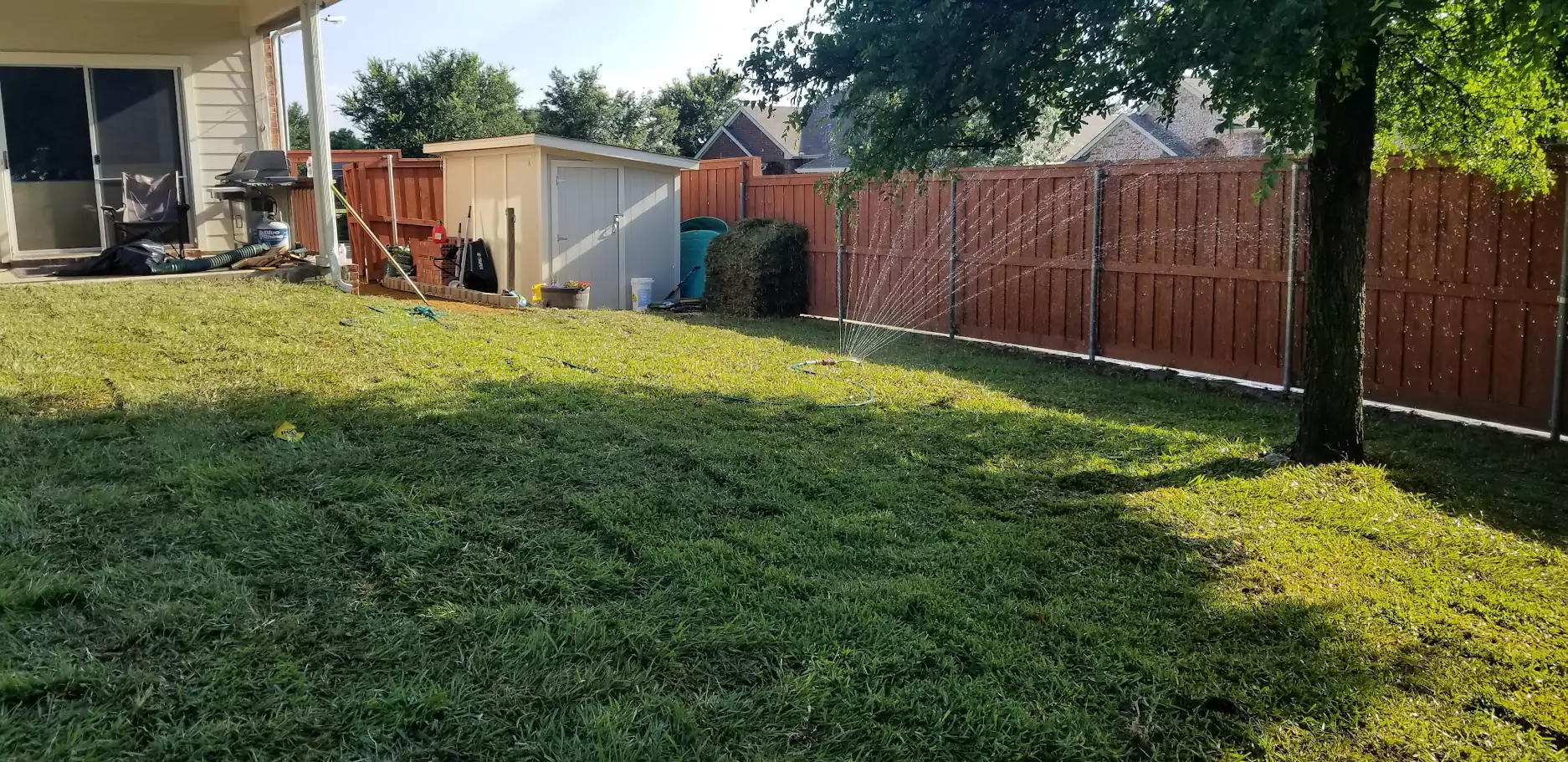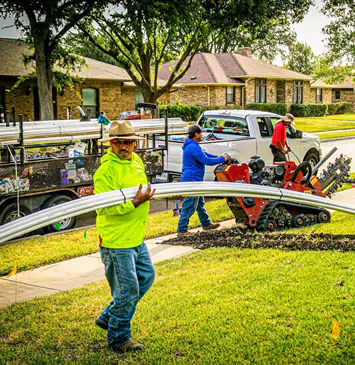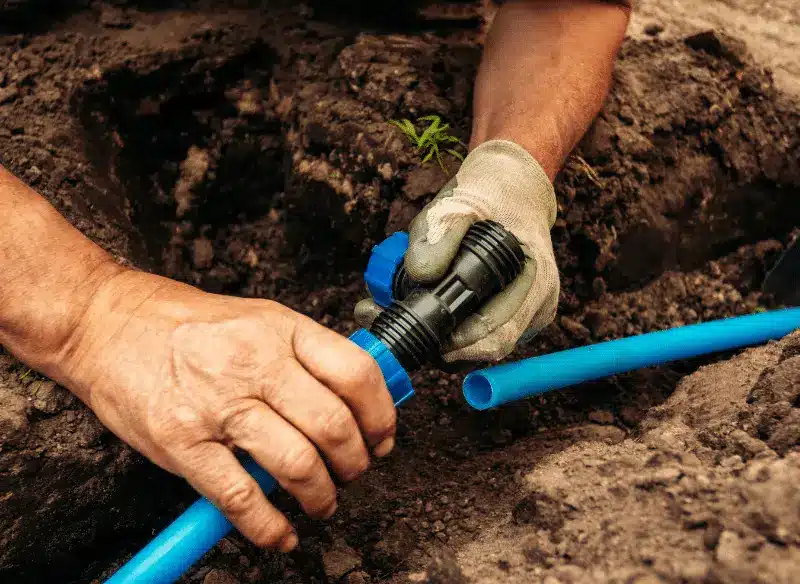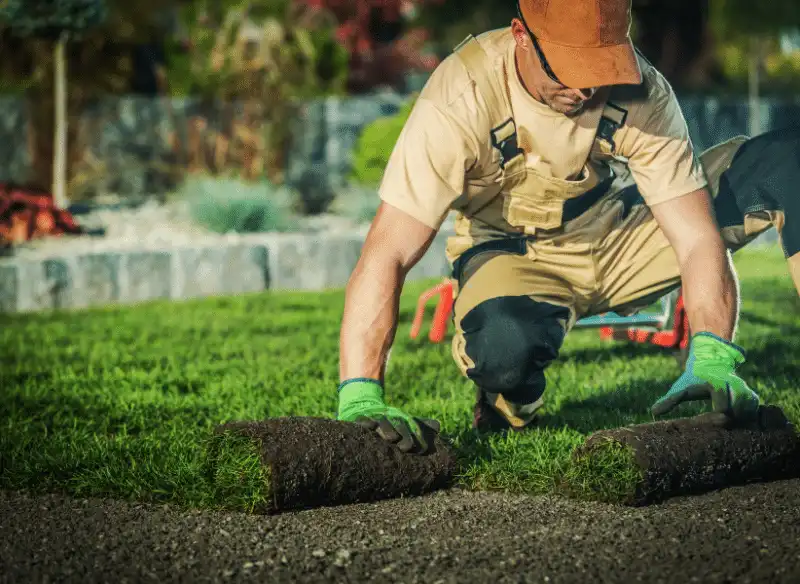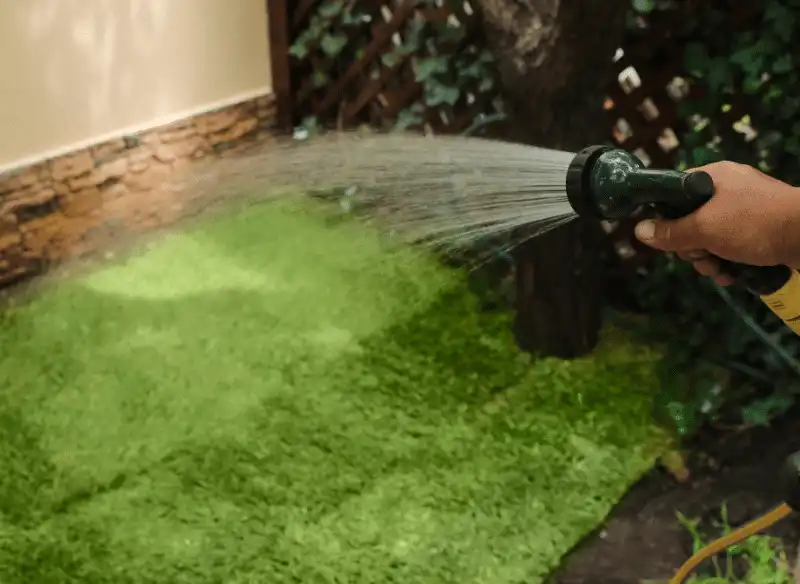In 2025, homeowners in Dallas-Fort Worth are investing on average about $7500, and the cost ranges anywhere from $4,000 to $15,000+ for a professionally installed system.
But what’s behind that price? As a licensed irrigator with over a decade in experience, I’m here to break it all down for you, so you can get the lush lawn you want without any guesswork.
What Affects the Cost of a Sprinkler System?
Let’s dive into the main factors that influence how much you’ll spend on a sprinkler system for your yard. These are the things you need to consider to ensure you’re getting the right system for your needs—and not paying for more than you should.
- Yard Size
- Sprinkler Design / Zones
- Soil and site conditions
- Smart irrigation costs / savings
- Permit costs
How Much Does Your Yard Size Impact the Cost?
This one’s simple: the bigger the yard, the more it costs. But it’s not just about how many square feet you have. The layout of your yard can add complexity. For example, a flat, open yard will be cheaper and easier to install in than a yard with lots of trees, slopes, or garden beds.
In Dallas-Fort Worth, the average ¼ acre lot (about 10,000 square feet) typically has a yard size of about 5,000 square feet.
A sprinkler system for an average DFW home would cost between $6500 and $9000. But that cost can increase if your yard has tricky features. And for larger yards, you can easily expect to pay $10,000 to $20,000.
Pro Tip: If you’re planning to redo your landscaping, think about simplifying your layout to keep sprinkler installation costs down. Fewer obstacles mean easier installation!
How do the number of sprinkler zones affect cost?
A sprinkler system is divided into zones, and each zone waters a specific part of your yard. While more zones might seem like they’d add to the cost, they actually help ensure you’re not wasting water by overwatering certain areas.
And before we continue, let’s clarify…
What is a sprinkler Zone?
A zone is a group of sprinklers (usually Rotors, Sprayheads, or drip) that get water when a valve opens. The sprinkler controller sends an electrical signal through a wire to tell the valve when to turn on or off.
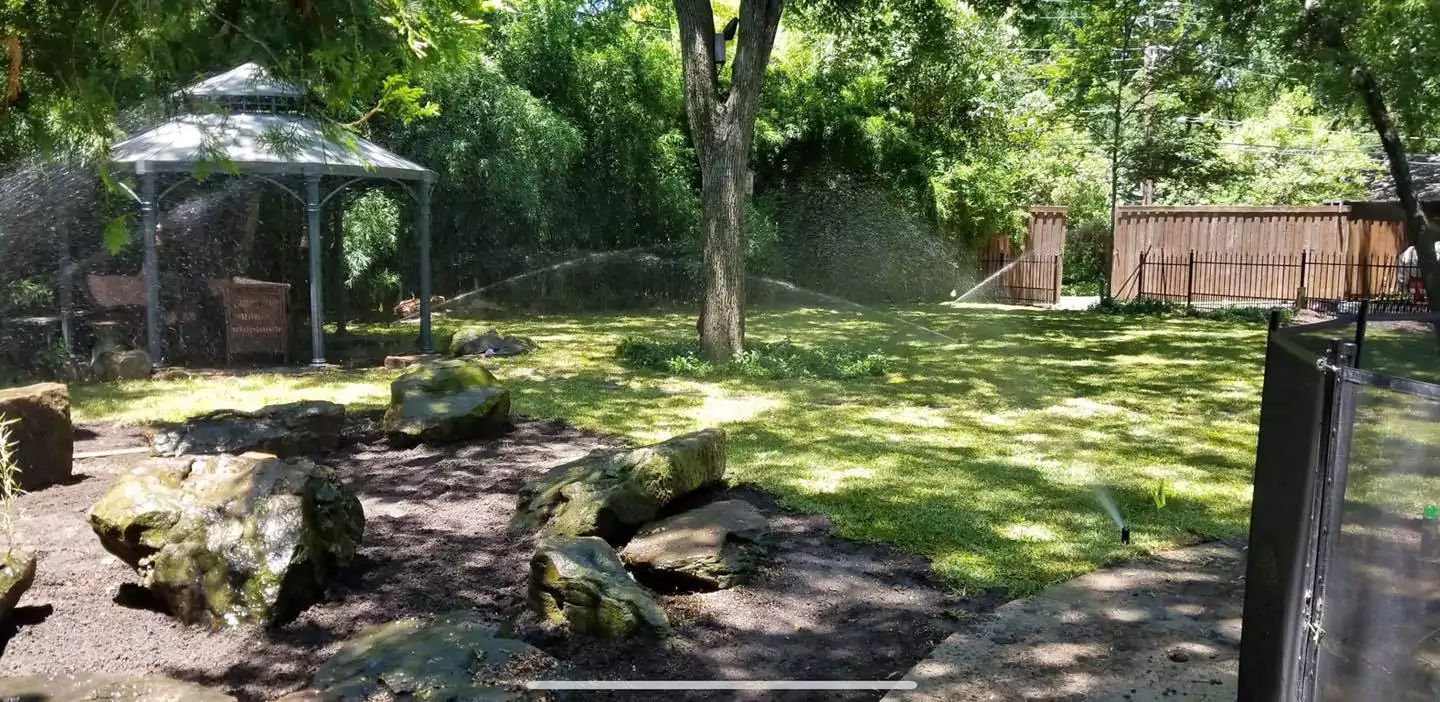
What is the average price per zone for sprinkler system installation in DFW Texas?
Roughly $800 to $1500 per zone from a licensed irrigation company.
But….
Why is it bad to “price per zone” for sprinkler system installation?
If you’ve called around to different sprinkler contractors you might’ve heard them say “price per zone”, or, our price is “x per zone”.
Pricing per zone is inaccurate and doesn’t take into account many of the needed details like, water pressure, water meter size, and yard layout.
For example, 2 yards that are both 10,000 square feet could be priced completely differently.
Let’s say these are the characteristics of the yards:
| Factor | Yard 1 | Yard 2 |
|---|---|---|
| Static Water Pressure | High (90 psi) | Low (38 psi) |
| Water meter size | Large (1 inch) | Small (Half inch) |
| Yard layout | Simple (square) | Complex (extravagant landscaping layout) |
Without giving you a full irrigation 101 class explaining all factors involved to price an irrigation installation, the above 3 differences have a huge impact on installation.
Yard 1 might cost $10,000 to install.
Yard 2 might cost $20,000 or more!
And it’s the same square footage!
Let’s do another example, where the two yards are very similar.
| Factor | Yard 1 | Yard 2 |
|---|---|---|
| Static Water Pressure | High (90 psi) | Decent (50 psi) |
| Water meter size | Large (1 inch) | Average (5/8th inch) |
| Yard layout | Simple (square) | Simple (square) |
Here, imagine two houses with large yards that have the exact same simple layout for the yard.
Both properties will have the same number and placement of sprinkler heads (probably rotary heads since it’s a large property).
Yard 1 might only need 7 zones to water the entire property.
Yard 2 might need 14 zones!
And it’s the same sprinkler layout with a similar amount of trenching and labor needed!
The only difference is you need to add 7 more valves to split up the water lines, and get a bigger controller.
If you have yard 2 and a contractor is pricing per zone they would DOUBLE THE COST of your sprinkler system when they might’ve only needed to add about $400 for a bigger controller and extra valves.
Now, understandably, you can sometimes get away with an average “price per zone” if most of the properties the irrigator works on are similar.
Why is it bad to “price per zone” for sprinkler system installation?
How can more sprinkler zones save you money in the long run?
More zones can lead to better efficiency of watering for your yard. You can have a zone for an area that has more shade, an area that has a steeper slope, or an area that is intricate in shape.
If you just did the minimum amount of zones, disregarding the differences in areas, you can end up wasting a lot of water.
You’ll end up with spots that are too dry, and spots that are too wet.
And what are you going to do when you see dry spots?
INCREASE THE AMOUNT OF TIME YOU WATER!
This will result in a ton of wasted water over months and years.
An inefficiently installed sprinkler system can cost you THOUSANDS of dollars on your water bill over the course of years, or even months!
Sprinkler Heads: Choosing the Right Type to Avoid Overwatering
An inefficiently installed sprinkler system can cost you THOUSANDS of dollars on your water bill over the course of years, or even months!
- Rotary Heads: These are ideal for large lawns. They rotate slowly and distribute water evenly over a larger area, which means fewer heads and less waste.
- Pop-Up Sprinklers: These are great for smaller or more standard lawns. They “pop up” when the system is running and are typically more affordable, but you’ll need more of them to cover larger areas.
- Drip Irrigation: Perfect for flower beds and landscaping, drip systems deliver water directly to the soil. They cost a bit more to install but are incredibly efficient and can reduce your water bill over time.
Example: One of my clients in Plano opted for rotary heads in their large front yard and pop-ups for their smaller backyard garden. The combination saved them on both water usage and installation costs by using the right heads for the right spaces.
Side note: NEVER mix Rotary heads with pop-ups with drip on the same zone! Only use sprinklers with the same precipitation rate, otherwise you will have non-uniform watering and you will WASTE WATER!
Why Your Soil and Yard Preparation Matter
If your yard has rocky or compacted soil, installation is going to be more challenging—and therefore more expensive. In DFW, we have a lot of clay and rocky soil, which can make trenching for pipes more difficult. This adds time and labor to the job, so expect to pay more if your soil needs extra prep.
While some areas are worse than others, Cedar Hill and the surrounding areas are notorious for their poor soil quality, full of limestone! This can increase your installation cost, and honestly, you might want it to.
If you hire an inexperienced irrigator who doesn’t understand the challenges of this type of soil and offers you a low bid, they could end up cutting corners—resulting in poor trenching, improper installation (shallow pipes and valves), or even damage to the system down the line.
It’s better to invest in a professional who knows how to handle tough soil conditions from the start, ensuring the job is done right, even if it costs a little more upfront.
Site preparation, which includes trenching, leveling, and clearing, can add an extra $1,000 to $2,000 to the total cost. But it’s an important step.
Skipping proper prep can lead to uneven watering, and shallow pipes and valves prone to leaking, which means more money spent down the line on repairs or extra water usage.
Smart Irrigation Systems: Worth the Extra Cost?
In 2025, smart irrigation systems are becoming increasingly popular, and for good reason. These systems can be controlled via smartphone apps, and they automatically adjust your watering schedule based on the weather.
Yes, smart systems can add anywhere from $500 to $1,500 to your installation cost, but they’ll help you save on water bills over time. Think about it: the system knows when it’s raining and shuts off, or it knows your soil is already moist and skips the next cycle. This kind of efficiency pays off quickly.
Fun Fact: I had a client in Southlake who added a smart controller and ended up cutting their water usage by 25% in just the first year! That’s a big deal when you consider how high water bills can get during the Texas summer.
But,
What is a Smart Irrigation System?
A smart irrigation system typically includes a controller that connects to your phone via Wi-Fi and integrates with local weather data.
These systems can automatically adjust your watering schedule based on current weather conditions, and they often come with additional sensors, like rain, freeze, or wind sensors, as well as flow control sensors to detect leaks or irregular water usage.
If you opt for a Rachio Pro or Hunter ProHC Hydrawise controller, they offer direct connections to weather stations and your phone, allowing you to skip extra sensors (like rain, freeze, or wind) if you want to save money. (But if you want a flow sensor that would be extra)
These controllers already provide weather-based adjustments, making them a great option for streamlining your setup.
Surprisingly, these smart controllers often cost about the same as traditional non-smart ones. In fact, they can be priced similarly to models like the Rainbird ESP-TM2, giving you added technology and convenience without a significant price difference.
Additional Costs to Consider
How much does a sprinkler system permit cost?
Before you install a sprinkler system in DFW, you’ll need to get a permit. Each city has their own regulations and fees. For example, Grand prairie has a $75 application fee, whereas Duncanville just updated their fee to $300.
Here’s the permit costs broken down:
| City Registration fee: | $50 to $300 | This fee is required to be paid once per year per city by your irrigator |
|---|---|---|
| City Permit application fee: | $50 to $450 | This is required for every new sprinkler system installation. |
| Professional CAD design: | $100 to $600 | Some irrigators will design the system themselves and add a fee, and some will hire a designer to do it for them. |
| Backflow Test | $85 to $200 | This is not through the city. The irrigator needs to hire an independent backflow tester who is licensed with backflows to test the backflow after your system is installed. They usually charge $85 to $200. |
| Backfill | $0 to $150 | Large holes in the ground are usually left open for inspection on key components: backflow, point of connection, master valve. Your irrigator might charge for the time and labor it takes to send a crew member to do the work. |
| In-person inspection walkthrough | $0 to $300 | Some cities, like Lancaster, require the irrigator to be present for the walkthrough with the inspector. However, the inspector might give a 5 hour window with no heads-up. This happens sometimes and your irrigator may need to budget for the time spent waiting for and walking through with the inspector. |
Many people think it’s just the “city application fee” for the permit cost. Hopefully the above chart gives you a good breakdown on what it truly costs an irrigator to get a permit for your sprinkler system.
Most irrigators will include some of these costs in the total project quote so you might not even see a breakdown.
In my experience, the total cost for an irrigation permit is usually around $450 to $900, all things considered.
Ongoing Maintenance Costs
No sprinkler system is truly “set it and forget it.” You’ll need to schedule regular maintenance to keep your system running smoothly, which usually costs $100 to $600 or more per year.
The newer the system the less maintenance you will need. You can get away with almost zero maintenance for the first year, but I wouldn’t recommend it.
If you’re in a part of DFW that experiences freezing temperatures, you’ll also need to winterize your system. Failing to do so can result in cracked pipes and expensive repairs. Winterization typically costs $75 to $200.
Why Hiring a Licensed Irrigator is Essential
You might be tempted to save a few bucks by going the DIY route, but trust me—installing a sprinkler system is one of those jobs best left to the pros. Here’s why:
Expertise and Compliance
As a licensed irrigator, I know the ins and outs of local regulations. More importantly, I understand DFW’s unique soil conditions, water usage challenges, and the importance of proper system zoning to prevent water waste. When you hire a pro, you’re ensuring the job is done right—and that it complies with local codes.
Avoiding Costly Mistakes
I’ve seen too many DIY installations that went wrong. One homeowner I worked with ended up with a yard full of soggy patches because they didn’t properly zone the system. The repairs? They ended up costing more than the original installation. Don’t be that homeowner!
Warranties and Peace of Mind
Most licensed contractors offer warranties on parts and labor, so you’re covered if something goes wrong. Plus, we always conduct a post-installation inspection to make sure everything is working perfectly.
How to Choose the Right Irrigation Contractor
If you’re ready to get a sprinkler system installed, make sure you choose a contractor with experience. Here are a few things to look for:
- Check for Licensing and Insurance: Always ask to see proof that your contractor is licensed by the Texas Commission on Environmental Quality (TCEQ) and fully insured.
- Ask About Warranties: Make sure your contractor offers warranties on both the parts and labor.
- Get a Detailed Estimate: Make sure they send you a detailed quote outlining the work to be done.
Conclusion
A sprinkler system in Dallas-Fort Worth is an investment, but it’s one that pays off in time, money, and water savings. With installation costs ranging from $4,000 to $15,000+, and the added benefits of smart technology and proper zoning, you’ll have a system that keeps your yard looking great while conserving water.
If you’re ready to take the next step toward an efficient and worry-free irrigation system, reach out for a custom estimate. I’m here to help you create the perfect system for your yard—without the headaches.
